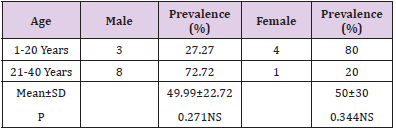Impact Factor : 0.548
- NLM ID: 101723284
- OCoLC: 999826537
- LCCN: 2017202541
Sabina Khanam*
Received: August 22, 2022; Published: September 02, 2022
*Corresponding author: Sabina Khanam, Department of Biological Sciences, Yobe State University, Nigeria
DOI: 10.26717/BJSTR.2022.46.007280
This study was carried out to determine the prevalence rate of malaria, measles and hepatitis among male and female of different age groups. The prevalence rate of measles is more in the children of more than five years of age in both the sexes. Males of age greater than five had the highest (60%) prevalence rate of measles and lowest (40%) in less than five of age. The highest (62.5% ) prevalence of malaria was found in females of age group 11-20 years and lowest(28.57%) was found in males of age group 11-20 and 21-30 years. In males the prevalence of hepatitis -A was highest in the age group 21-40(72.72%) while in case of female the prevalence of hepatitis-A was highest in the age group 1-20(80%).
Keywords: Malaria; Measles; Hepatitis A; Prevalence
Measles, malaria and hepatitis are the major problems in children as well as in adults in Africa, Europe, and South-east Asia [1]. Measles is one of the disease of under five child mortality in Nigeria. The reason behind this is may be delaying vaccination which may increase the complications of this disease [2,3]. In Sub Saharan Africa measles is the major cause of mortality and morbidity with around 650,000 deaths and around 13 million measles cases annually [4]. Around 1.5 million people are affected by hepatitis A virus each year globally. It is the important public health problem globally in middle income and low income regions [5]. Malaria is a disease caused by the parasite Plasmodium species. It is distributed largely in warmer regions of the world. Development of the malarial parasite in red blood cells may cause various clinical symptoms. Malaria infection transmitted through the infected female anopheles mosquito. The symptoms are: High Fever, Chills and shivering, Chest and abdominal pain, Enlargement of liver and spleen, Pulmo nary edema, Black water fever [6]. Approximately a total of 30% of malaria cases are from the Nigeria in whole african continent which affects the Nigerian economy with a loss of approximately 700 million USD in prevention and treatment . In Nigeria malaria mainly control by taking Chloroquine drug because it is the cheapest antimalarial drug [7-9].
This study was carried out in Damaturu Local Government, Yobe State, Nigeria. According to 2006 census the population of Damaturu is 88,100 with 25.2oC average temperature.
The climate here is considered to be a local steppe climate, there is little rainfall throughout the year. This location is classified as BSH by Koppen and Geiger in Damaturu, the average annual temperature is 25.2oC. in a year, the average rainfall is 649mm.
The data was collected from General Hospital , Damaturu for the analysis.
Prevalence rate was calculated by using the following formula
Prevalence rate =  ×100
×100
Table 1 shows prevalence rate of male and female of different age groups. A total of 15 subjects were participated in the study. Out of 15 participants 10 were male and 5 were female. Males of age greater than five had the highest (60%) prevalence rate of measles and lowest (40%) in less than five of age. All the 5 females belongs to age greater than five. In 2006, 383 measles cases, in 2007, 2542 and in 2008, 9510 cases has been reported in Nigeria [10,11]. There are some some evidences which shows that measles virus indirectly affects the central nervous system which leads to electroencephalographic abnormalities in early stages of measles [12,13]. Table 2 shows the prevalence rate of malaria among male and female of different age group. A total of 15 participants were taken for the study. Out of 15 participants 7 were male and 8 were female. In males out of 7 participants 3(42.85%) were belongs to age group 1-10 years, 2(28.57%) of age group 11-20 and 2(28.57%) of age group 21-30 years. In females out of 8 participants 3(37.5%) belongs to age group 1-10 years and 5(62.5%) of age group 11-20 years.
Table 3: Prevalence Rate of Hepatitis- A Among Male and Female of Different Age Group.

Note: *This study
The highest (62.5%) prevalence of malaria was found in females of age group 11-20 years and lowest(28.57%) was found in males of age group 11-20 and 21-30 years. Some researchers in Nigeria found 64% (128/200), 59.6%(118/198) and 58%(233/400) prevalence of malaria cases in children of Kebbi State, Awka and Abuja respectively [14-16]. Table 3 shows the prevalence rate of hepatitis-A among male and female of different age group. A total of 16 participants were taken for the study. Out of 16 participants 11 were male and 5 were female. In 11 male participants 3(27.27%) were belongs to age group 1-20 and 8(72.72%) were belongs to age group 21-40. On the other hand out of 5 female participants 4(80%) were belongs to age group 1-20 and 1(20%) participant belong to age group 21-40. In males the prevalence of hepatitis -A was highest in the age group 21-40(72.72%) while in case of female the prevalence of hepatitis-A was highest in the age group 1-20(80%). Ikobah, et al. [17] studied that the highest prevalence rate of hepatitis- A virus was in the 21-30 years of age group 84(5.5%)and 55.2% of prevalence rate reported in the study of children from Nigerian rural community. A similar study was reported by Nwolisa, et al. [18], and he reported that the infection of hepatitis B virus was highest in males.


